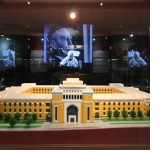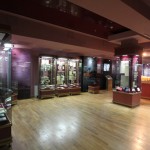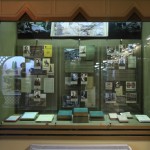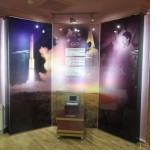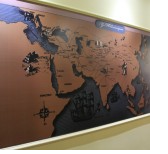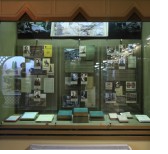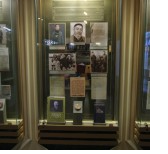The Museum of the History of Science in Kazakhstan was established in order
to record the history of science of the country and pay tribute to the
outstanding scientists who shaped that history.
The museum exhibition is divided into three sections:
1. The history of science in Kazakhstan from ancient times. The beginnings of science in Kazakhstan: the scientists of the 19th century.
2. The development and formation of science in Kazakhstan in the Soviet period
3. Science of independent Kazakhstan.
Section 1: The history of science in Kazakhstan from ancient times. The beginnings of science in Kazakhstan: the scientists of the 19th century.
It is known that the history of culture, education and scientific thinking of the Kazakh people has deep roots, originating in ancient times with outstanding thinkers such as Al-Farabi, Mahmoud Kashkari, Zhusup Balasaguni, Kadyrgali Zhalayri, and Ahmet Yassawi.
Abu Nasr Al-Farabi (870-950) was a renowned scientist and philosopher of the Islamic Golden Age. He was also a cosmologist, logician, and musician. Through his commentaries and treatises, Al-Farabi became well known among medieval Muslim intellectuals as ‘The Second Teacher’, that is, the successor to Aristotle, ‘The First Teacher’. His main works are: ‘The Gems of Wisdom’, ‘The Tractates of the Views of the Citizens of a Virtuous City’, the treatise, ‘On the classifi cation of the sciences’, ‘The Great Book of Music’ and others. In his treatise ‘On the classifi cation of the sciences’ Al-Farabi surveyed the full range of sciences known in his time: linguistics, logic, mathematics, physics, metaphysics and civil science. The contribution of Al-Farabi to the global methodology of science is tremendous.
Yusuf Balasaghuni was one of the greatest poets of the 11th century, a brilliant thinker, scholar and lexicographer, a philosopher and a well-known public figure. He was the author of the poem ‘Kutadgu Bilig’ (The book of happiness) in the Turkic language.
Mohammed Haydar Dulati was a historian, writer, statesman and the author of ‘Tarikh-i-Rashidi’ and the poem ‘Jahan-nama’. His historical work Tarikhi - Rashidi (The history of Rashid) is a personal memoir combined with a Central Asian history. It contains important information on the history of East Turkistan, Kazakhstan and Central Asia in the 15th to the fi rst half of the 16th century.
Khoja Akhmet Yassawi was a poet of the Middle Ages and a prominent representative of Turkic Sufi poetry. His knowledge of poetry, literature and philosophy of the East was very deep. His cycle of poems, ‘Divan Hikmet’ (The Book of Wisdom) has a philosophical nature and sets out the basic rules and dogmas of Islam: the asceticism, tolerance and humanist ideas which urge people towards justice, honesty and kindness.
This section of the exhibition is also devoted to the Russian scientists and researchers from Central Asia and Kazakhstan who made signifi cant contributions to the development of science in Kazakhstan. An enormous amount of factual material on the history and culture of the Kazakh people was systematized and generalized in the works of such scientists and historians as Nikita Bichurin, Grigory Spassky, Aleksey Levshin, Vladimir Velyaminov-Zernov and Vasily Grigorev.
From the mid-19th century Kazakh scientists began toplay an important role in thedevelopment of scientificresearch in Kazakhstan.One of the fi rst Kazakh scientists whose works greatly enriched the world of oriental historiography was Chokan Valikhanov. The prominent Kazakh pedagogue and enlightener Ibray Altynsarin and the great Kazakh poet Abay Kunanbayev also made a signifi cant contribution to the scientifi c life of Kazakhstan.
The Russian Geographical Society (RGS) played an important role in the study of the territory of Kazakhstan. A division of the RGS was established in Orenburg in 1867 in order to conduct a study of Western and Northern Kazakhstan. In order to study Southern Kazakhstan and other parts of Central Asia, the Turkestan division of RGS was established in 1887. These branches conducted research into geography, natural history and ethnography of the area. The Orenburg Scientifi c Archives Committee (OSAC) was established in December 1887 and the Museum of History and Archaeology was opened in 1888. A member of the Orenburg Scientific Archives Committee, Joseph Kastane conducted several excavations and made a list of the monuments of the ancient cultures of the Kazakh steppe.
Section 2: The development and formation of science in Kazakhstan in the first half of the 20th century: a gallery of portraits of the presidents of the Academy of Sciences of the Kazakh SSR
This section of the exhibition is devoted to the history of the Kazakh Branch of the Academy of Sciences of the USSR. The gallery presents the portraits of and materials about the presidents of the academy since its foundation: Dinmukhamed Kunayev, Shafik Chokin, Kanysh Satpayev, Shahmardan Esenov, Askar Kunayev, Murat Aythozhin, Umirzak Sultangazin, Kenzhegali Sagadiev, Vladimir Shkolnik, Nagima Aitkhozhina, Serikbek Daukeyev and Murat Zhurinov. A separate display case is devoted to the first president of the Academy of Sciences of the Kazakh SSR, Kanysh Satpayev, prominent statesman, worldrenowned scholar, founder of the Kazakh school of geologists, discoverer of the Zhezkazgan copper deposit in Kazakhstan, academician of the Academy of Sciences of the USSR and laureate of the Lenin and State prizes of the USSR. Such works of Kanysh Satpayev as ‘Selected Works’ in fi ve volumes, published in 1967-1970 and the textbook ‘Algebra’ for Kazakh schools, published in 1924, are on display.
Section 3: Science of independent Kazakhstan.
The museum staff have been conducting studies on the history of scientific research institutes established at the Academy of Sciences of the Kazakh SSR and National Academy of Sciences of the Republic of Kazakhstan. The exhibition focuses on the scientific work and achievements of eminent scientists of the country who have made signifi cant contributions to the development of science in Kazakhstan.
The museum’s unique memorial exhibits include a typewriter that belonged to the academician Smet Kenesbayev, a linguist and specialist in Turkic philology and one of the founders of Kazakh linguistics. In the early 1930s he was among the first of the Kazakh linguists to focus on solid academic preparation and systematized teaching practice. The fruit of his forty years of work, ‘A Kazakh Language Phraseological Dictionary’, in which he collected, systematized and analysed the rich and unique linguistic creativity of the Kazakh people, was published in 1977.
The museum displays a collection of minerals gathered by the engineer Komarov in 1966 and gifted to the academician, Shafik Chokin. The collection consists of 166 minerals, such as quartz, copper, opal, pyrite, bauxite, marble, lapis lazuli, phosphorite, jasper, topaz, nickel, malachite and others. Komarov arranged them in a pyramid shaped mound, on top of which he placed a sculpture of an eagle. He left a cavity inside the pyramid in which he placed a sculpture of a deer. This exhibit is intended to demonstrate the diversity of the mineral resources of Kazakhstan.
The academic, Umirzak Sultangazin, was the director of the Space Research Institute of Kazakhstan from its establishment. The exhibition presents some of his personal belongings and a notebook computer given to him by his Japanese colleagues from the University of Kyoto. The notebook is unique not only because it belonged to the academic, but also because it is an example of one of the first portable computers.
The museum exhibition also includes scientific research materials of the scientists of the Aitkhozhina Institute of Molecular Biology who developed high-tech biological technologies for the diagnosis of diseases in human and veterinary medicine. One of the exhibits is a sample of the test system based on polymerase chain reaction, pioneered in Kazakhstan, for the determination of causative agents of human infectious diseases including reproductive tract infections, gastric and duodenal ulcers and tuberculosis, and brucellosis in animals. Also on display are the patents for the potato varieties ‘Tokhtar’ and ‘Orbit’, which were developed in space and named after Kazakhstan’s first cosmonaut.
To date, the history of science in Kazakhstan has been presented in the various memorial museums across the country only partially and no single museum has presented an overall picture of the development of the science of independent Kazakhstan. The Museum of the History of Science of Kazakhstan is the first museum established to study and popularize the complete history of science of the whole country.
The museum staff organizes and conducts permanent and temporary exhibitions and scientific and educational activities. Regular lectures are also provided along with thematic meetings and evenings with the students of schools and universities.